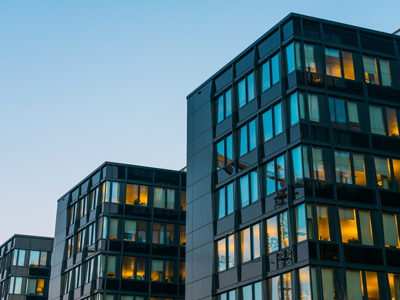 A crucial step that every installer will negotiate during fiber cable installation in an apartment block or multi-story office building is to decide on the most appropriate way of getting the fiber cable from the basement of the building to each floor.
A crucial step that every installer will negotiate during fiber cable installation in an apartment block or multi-story office building is to decide on the most appropriate way of getting the fiber cable from the basement of the building to each floor.
In new-build apartment blocks and commercial buildings, this process can often be fairly straightforward - and especially so if the architect has designed the building with fiber in mind and has included a microduct from the basement to each of the floors.
For the network operator the key step is deciding on the best method of getting the cable to each floor - whether that’s by blowing, pushing or pulling the fiber cable. Here we explore the pros and cons of each approach.
Blowing fiber
While blown fiber is a tried and tested method, it's not necessarily optimal for in-building deployments. Heavy gasoline-powered compressors are not always suited to basement applications. In addition, some developers may simply not allow compressed air, which might carry dirt and water, to be blown into their buildings. The key advantage with blowing though is distance, so in some high-rise scenarios it may be the only realistic choice.
Pros:
- Tried and tested method
- Distance - viable option for high-rise buildings
Cons:
- Not always optimized for in-building deployment
- May not be ideal in basements due to heavy gasoline-driven compressors
Pullable fiber cable
One of the biggest advantages of pullable cable is cost. It also relies on minimal extra equipment and has a proven track record in most regions. However, it can be a labor-intensive process unless a pull-cord is already in place. Some installers prefer a cable-rodding approach, but with that comes the risk of overstressing the cable. Excessive tensile load during the pulling process also has the potential to damage the fiber, as can any encounters with obstacles along the cable’s path.
Pros:
- Cost advantage
- Proven track record
- Little extra equipment required
Cons:
- Potential for damage to cable from obstacles
- Labor intensive
- Risk of overstressing cable
Pushable cable
Inexpensive pushing equipment enables cables to be pushed manually up to 100 meters or further. And if done in conjunction with pre-termination, the pushing process is quick and efficient.
Read our eBook to find out how pushable fiber makes FTTP fast and affordable:
Pros:
- Inexpensive pushing equipment
- Quick and efficient
- Can be pushed manually up to 100 metres
Cons:
- Older buildings may have congested or ill-planned conduits
Troubleshooting
In older buildings in particular, there may only be PVC electrical conduits in place or they may be pre-populated with other types of existing infrastructure. While a well-designed microduct path might allow 50-100 meters of cable to be pushed and/or pulled through it, a congested or poorly-planned conduit might only accept as little as 15-25 meters of cable.
In addition, sometimes there is no obvious means of getting the fiber to the floor at all. So what options do network operators have in these situations?
If there is no pre-existing infrastructure in place to transport the cable, operators will use whatever spaces are available in the building. There may be an elevator shaft which the cable can be dropped from the floors above or it may be possible to tack or glue the cable to walls, ceilings or plenum spaces. A slightly more aesthetic approach is to use cable trunking or some other method to conceal the cable.
Fire protection
Whatever type of cable is used for this stage of an in-building installation, it will need to meet local fire regulations. Fire regulations for fiber cable protection vary from region to region. A cable suitable for use indoors in one country may not be allowed in an identical building structure elsewhere in the world.
The approach in the U.S. is based on the idea that it's better to control the release of heat - the two primary requirements for fiber cables is they shouldn’t propagate fire and they can self-extinguish.
In contrast, in Europe it’s toxicity and the minimizing of smoke density that are often believed to be more important than flame propagation.
Installers should always check the fire regulations wherever they are operating before installing fiber in a building. Failing a building inspection can be costly, both in terms of revenue and reputation.
The best method of routing fiber cable to each floor of an apartment or office building depends upon many factors - from the age and size of the building, and state of any existing infrastructure, to local regulations. Installers have a number of options when approaching an installation so it will always be a case of matching the best solution to each individual scenario to achieve the optimum result of the customer.



Comments